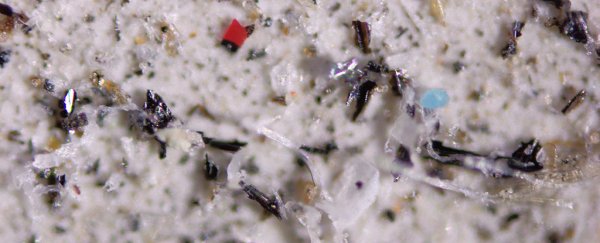Our plastic pollution problem has become so bad that microplastics are now embedded in the regular cycles of the atmosphere, circulating around the planet like oxygen or water, according to a new study.
Plastic particles sent up into the air from ocean spray and road surfaces travel across continents and reaching the most remote spots on Earth, according to a mix of sampling and modeling done by researchers.
Much of this plastic appears to have been circulating through our ecosystems for a long time – highlighting just how much of a massive clean up operation we've got on our hands if we're to reverse the plastic tide.
"We found a lot of legacy plastic pollution everywhere we looked," says geological scientist Janice Brahney from Utah State University. "It travels in the atmosphere and it deposits all over the world."
"This plastic is not new from this year. It's from what we've already dumped into the environment over several decades."
Between December 2017 and January 2019, researchers collected 313 samples of airborne microplastics from 11 different sites across the western US. They found that 84 percent of the plastic particles came from road dust, 11 percent originated from sea spray, 5 percent came from agricultural soil, and 0.4 percent was put down to population sources.
In other words, this is mainly plastic that has been ground down on roads or whipped up from garbage patches in the ocean. Microplastic pollution isn't just concentrated around urban areas – it's getting everywhere, carried on the wind.
The findings were then plugged into a computer model to try and figure out what the worldwide pattern of atmospheric plastics might look like. Time spent in the air for the particles could range from an hour to almost a week, the team deduced – long enough for the plastic to travel the continents.
While the remote wilderness of Antarctica isn't exporting any airborne microplastics, it's very likely to be importing them, the model showed – and it's a similar story across the planet. Microplastics are accumulating just about everywhere scientists look, including national parks, with the highest concentrations estimated to be over the oceans.
"Using our best estimate of plastic sources and modeled transport pathways, most continents are net importers of microplastics from the marine environment," says Natalie Mahowald from Cornell University. "This underscores the cumulative role of legacy pollution in the atmospheric burden of plastic."
While the modeling part of the study uses some guesses and estimations to map out airborne microplastics on a global scale, there's little doubt that these polluting particles are very much blowing in the wind.
To date, nearly 10 billion metric tons of plastic have been produced globally since the early 1900s, and it's estimated that between 12-18 percent of it isn't accounted for by landfills, recycling, or incinerating.
The team behind this latest study is calling for more research into where all of this plastic ends up and how it might be distributed worldwide – affecting ecosystems, wildlife, the food chain, and ultimately our health.
"We did the modeling to find out the sources, not knowing what the sources might be," says Mahowald. "It's amazing that this much plastic is in the atmosphere at that level, and unfortunately accumulating in the oceans and on land and just recirculating and moving everywhere, including remote places."
The research has been published in PNAS.
